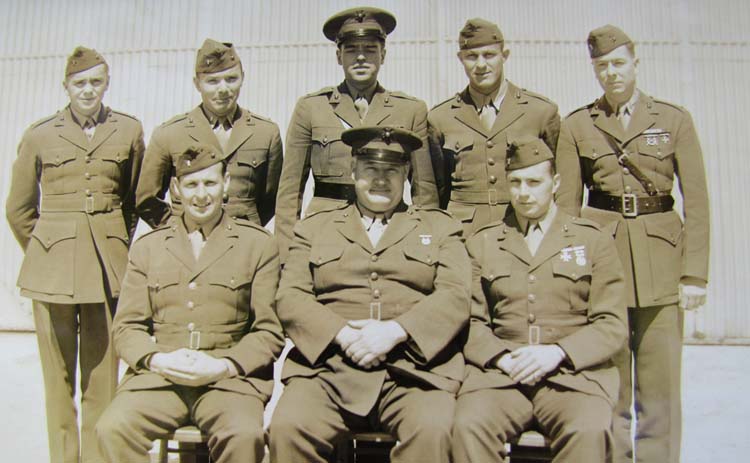
On April 11, 2010, I traveled to Harrodsburg, KY where I met with my good friend, Howard “Buddy” Howells. Buddy is the only grandson of the famous Col. George M. Chinn, author of the five-volume series entitled The Machine Gun. The last time I was in Harrodsburg was in 1985 when I met with Col. Chinn and Buddy at their office. I was working for FN and went there to discuss the Mk19 and to get Chinn’s opinion on the maturity of the design and the producibility of the weapon using the drawing package developed by the Navy.
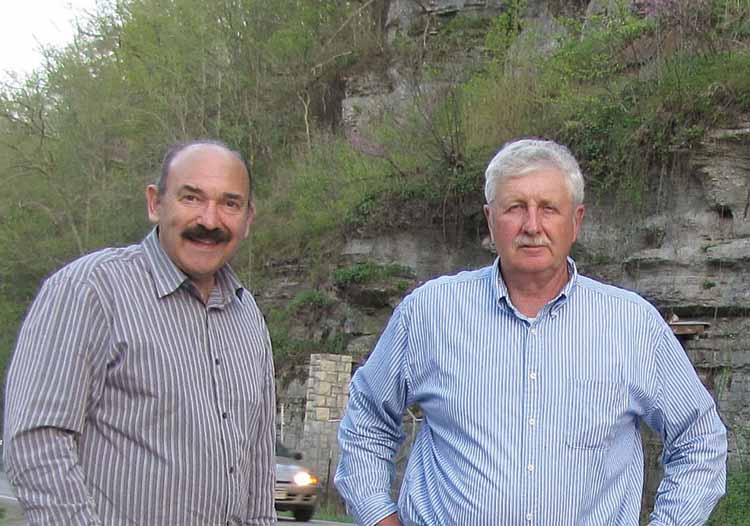
George Chinn had accumulated a wealth of firearm information through the years and was inspiration to many of us in firearm design. The Colonel made great contributions to firearm design and usage, and his historical reference book series is a classic of the last century. Buddy worked with his grandfather on some firearm designs and has an amazing memory of historical facts.
Buddy suggests we begin our meeting in the office used by George M. Chinn. Upon entering I can’t believe what I’m seeing. Chinn’s favorite pictures, letters, commendations, and other memorabilia still adorn the walls. Pencils, Rolodex, pads of paper and reference material are out on his desk. It was if the old master would return at any moment. Unable to resist the urge, I sit in the Colonel’s chair. Now was a good time to begin the interview.
George: Before we talk about George M. Chinn, could you give me a little insight into the Chinn family history.
Buddy: The Chinn’s are an old pioneer family with roots in Mercer county Kentucky. I know you remember my grandfather joking about being Chinese, but our ancestry is French. George’s Grandfather Jack was into horse racing and even owned a Kentucky Derby winner. Politics, farming, and Calcite mining were also family businesses.
George: So, as pioneers and frontiersmen, the Chinn family must have been around guns all the time.
Buddy: Actually, they were familiar with both ends of a gun. Back in 1900 Kentucky elected William Goebel as Governor. Just one day before his inauguration, Goebel was standing on the capitol steps between his two bodyguards, one of them Chinn’s Grandfather Jack, when a shot rang out. A sniper shot Goebel, fatally wounding him. Following his passing and true to the Kentucky sense of fairness, for the first time in U.S. history, a dead man was sworn into office. George: What about George Chinn? Did he have an interest in firearms when he was a youngster?
Buddy: Chinn’s father was the warden of the prison in Frankfort, Kentucky. This gave George many opportunities to disassemble guns from prison assets. Chinn had access to explosives too, from the family’s calcite mine. He led a charmed childhood and like most kids of that era, he enjoyed target shooting and plinking.
George: Tell me about George Chinn’s early education and his career plans.
Buddy: George went to a Millersburg Military Institute, a boarding high school where he was a member of the “Saturday Afternoon Tea Club.” That’s what they jokingly called the Reserve Officers Training Corps (ROTC) program. He graduated in 1920 in a class of nine. Since he was in ROTC at the close of WWI, he received a WWI victory medal even though he was never in theater.
George: I read where Chinn graduated from Centre College where he claimed to have majored in “football and penmanship.” What can you tell me about his football career?
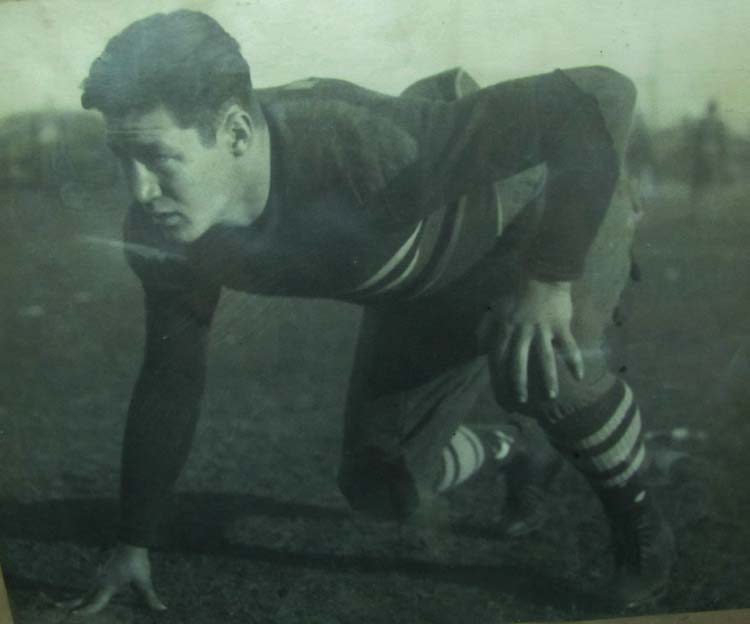
Buddy: As a freshman George played lineman on the Centre team that won what would today be recognized as the national championship in 1921 after beating Harvard 6-0. It was a huge upset. The Centre team was coached by two of the greats in football history, Charlie Moran and Robert Myers. These men greatly influenced George. Their coaching style and football experience itself made a huge impact on his life. Also significant was the relationship he developed with Albert. B. “Happy” Chandler, a guy who was a kind of team “groupy.” Happy rode along on the football trips and in later life became Governor of Kentucky – twice. He also served as a U.S. Senator, giving George an important political connection during much of his adult life.
George: What did Chinn do after college?
Buddy: He coached football; assistant coach at Bucknell and head coach at Catawba. His coaching experience was very valuable throughout his career. He refined his coach’s instinct and he knew how to prepare a team for an “operation” by making sure his players knew what to do, how to do it, and had the right equipment and training to get the job done right. This mentality served him well in later years when he helped Naval aviators and Marines with the operation, repair, and maintenance of automatic weapons.
George: But he didn’t stay in coaching – what happened?
Buddy: While he was vacationing in North Carolina he had an opportunity to visit a tourist attraction there called the Bat Cave. The sight of all those tourists buying food, drinks, and souvenirs got him thinking. He owned a piece of property alongside the road near the Brooklyn Bridge that crossed the Kentucky River. So near this scenic river, George knew it would be a good place for a tourist stop except that the property was a sheer cliff: almost all rock, and nearly 150 feet high. Chinn had the perfect spot and all he needed was a cave. That part wasn’t any problem at all as he knew an explosives expert named “Tunnel” Smith and had him blast a hole at the base of the cliff. The tunnel went straight in about 20 feet and then veered to the left about 100 feet. At the front entrance he built a grill with a snack bar counter on the left and directly across from it was the bar. Chinn designed the bar in a particular way that discouraged people from hanging around it. George wanted customers to buy drinks, but he didn’t want to make a hangout for potential troublemakers. Out in front were tables for people to sit after they’d gotten their food and drink. Through the years there were several modifications, including a pair of columns that were made from the same stone as Chinn’s house.
George: This had to be during the depression. There couldn’t have been the same level of tourist traffic that Bat Cave had in those years, did he make any money?
Buddy: George did very well there. My grandmother made delicious sandwiches for what could be called a “giveaway” price. These were prohibition years; the real money was made from liquor and slot machines.
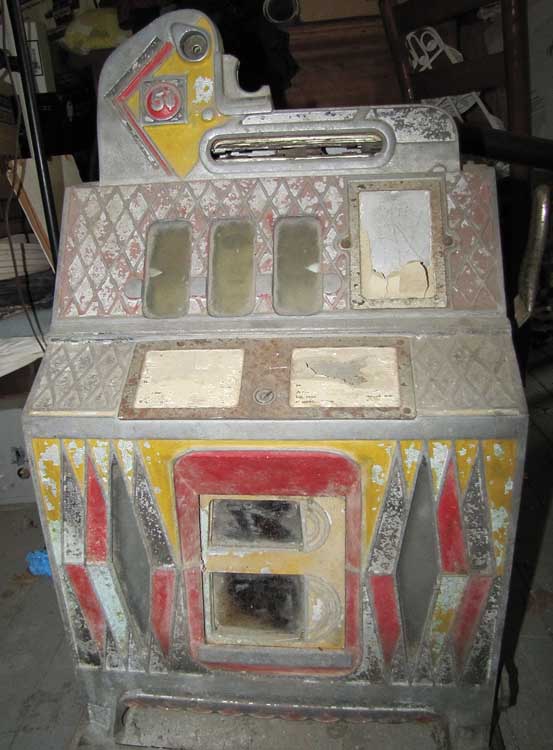
George: Slot machines?
Buddy: He had penny and nickel slots in the back part of the cave. Chinn was doing great until the law caught up with him. He was charged with running “a game of chance” at Chinn’s Cave House. In typical self-assured Chinn fashion, he defended himself and was able to convince the court that “you didn’t have a chance” when you gambled at Chinn’s.
George: It sounds like George has led a charmed life. Did this magic continue?
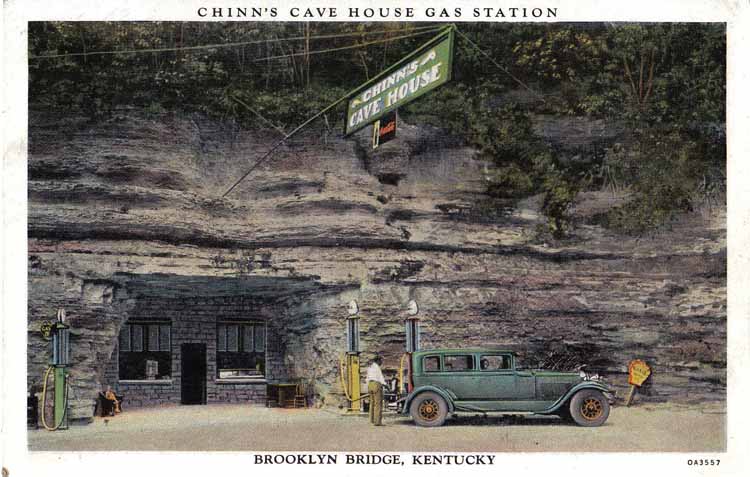
Buddy: Well, no. A life-changing event happened at The Cave House near the end of its operation. George got into an argument with the owner of the business across the road. Somehow it escalated to the point of violence when the neighbor entered the Cave House and shot George in the leg. George was wearing his .38 revolver at the time but he didn’t want this thing to escalate so he didn’t go for his gun. George’s wife, Cotton, however, tried to get Chinn’s gun away from him. It was all George could do to keep his wife away from that revolver. My grandmother was a crack shot and George was certain she would have killed the guy. Accompanied by his wife and daughter, Ann, Chinn went immediately to the hospital to get his wound cared for. My mother Ann, who was quite young at the time, recalled she had never seen so much blood in her life. Chinn got patched up and carried that slug in his leg for the rest of his life.
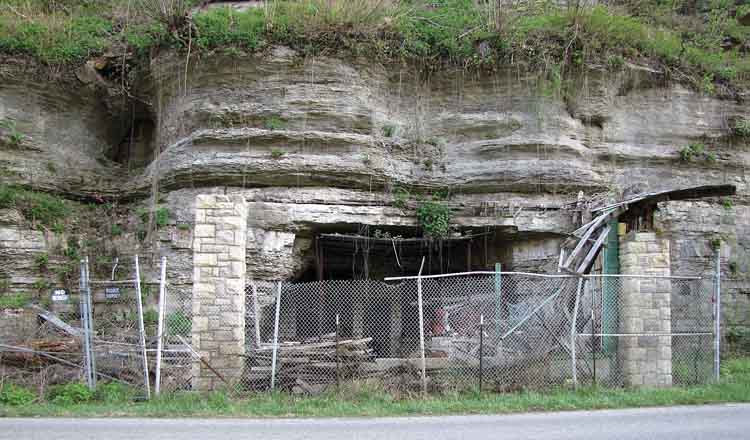
George: What did Chinn do after the Cave House?
Buddy: George was a pretty tough guy in his youth. His friend “Happy” Chandler described Chinn as, “That tough little river rat from Murdy’s Landing,” and hired him to be his bodyguard during his first term as Governor of Kentucky. Chinn also served as Sergeant-at-arms of the Kentucky legislature. You know, he had a flair for the unusual. Instead of buying a house in Frankfort, he bought an old ferry boat and converted it to a houseboat. George picked up other odd jobs too, like serving as Jack Dempsey’s bodyguard whenever he was in the area. (On the wall is an autographed picture of a young, rugged George Chinn standing with a group of men, one of them is Jack Dempsey. Jack’s inscription thanks him for his service.)
George: With a few exceptions, he seems to have led a charmed life to this point.
Buddy: George always said “I have lived my life in reverse.” He was too young for the First World War and lived a carefree life between the two wars, even though it was during the depression. In the late 1930s when our allies were looking to us to supply them equipment to fight the Germans with, Chinn took a job with the U.S. Government, as an inspector at Frigidaire in Dayton Ohio. He worked in the weapon section where the .50 cal. aircraft machine gun was in production. Through the years, Chinn had become even more interested in guns and collaborated on a book with his cousin, Bayliss Harden. (Buddy points to a framed letter from J. Edgar Hoover thanking George for the book, the Encyclopedia of American Hand Arms, he had received from Chinn.)
George: George was pretty old when the U.S. entered WW II. Did he try to enlist?
Buddy: He did. Prior to the war, a military recruiting train came through Harrodsburg taking applications and collecting résumés, and George submitted his, but he was already 37 years old. He knew he was not likely to be called up, and he wasn’t.
George: So, how did he get into the U.S. Marine Corps?
Buddy: He called in a political favor. His buddy “Happy” Chandler had moved on to become a U.S. Senator. Happy was not at all in favor of Chinn entering the military at his age. Chandler told him: “George, you are too big and too old to get into the military now. You’re going to get somebody hurt.” But Chinn insisted, and with Chandler’s help he enlisted into the Marine Corps, graduating from Aviation Ordnance School in 1943. (Buddy motions me over to a photograph on Chinn’s wall. It’s George’s graduation photograph from Aviation Ordnance School with our star graduate obviously older and substantially heavier than the other grads.) You know, George thought the whole thing about his weight and age was all very funny. Almost monthly, a Navy doctor would notice him on base and order him to come in for a physical exam. You see, any Marine perceived to be out of shape was a reflection on the competency of the Navy medical corps.
George: So it’s World War II, Chinn is an Aviation School graduate. Where is he assigned and what does he do?
Buddy: Most of the time he’s at Patuxent River Naval Air Station, but he was on something akin to a permanent TDY (temporary duty). He traveled around to various military installations checking out problems with guns and seeing if he could help with a solution. Whether it was a tool, a muzzle device, an operation or maintenance issue, or a design change, George was on the spot to help. His work was obviously appreciated as he received a number of commendations and promotions as a result. Chinn had a priority card that let him take flights and bump other people whenever there was a gun problem he was called in to review. Others had cards with higher priority but he told me he used that card for many years and only got bumped once; by the Manhattan Project Oppenheimer’s people.
George: After the War, Chinn is still in the military, and Korea starts up. What does he do then?
Buddy: Again he served as a troubleshooter for field problems. He traveled a lot, solving field problems, developing gages, tools, and helping with designs changes. He was called in to help with an engine flameout problem on the F7U aircraft caused by the ingestion of gun gas. The test pilot was none other than John Glenn. Chinn designed a muzzle device that solved the problem and was ultimately patented. Chinn is remembered in John Glenn’s memoirs for this brilliant and expedient solution. George had befriended John Glenn and baseball great, Ted Williams, as well, as they were both fighter pilots during the Korean War. (Buddy digs through a box of parts and retrieves a sample muzzle brake and shows me a copy of a patent that is framed and hanging on the wall.) It was also during the Korean War years that the Navy Department got George started writing The Machine Gun book series.
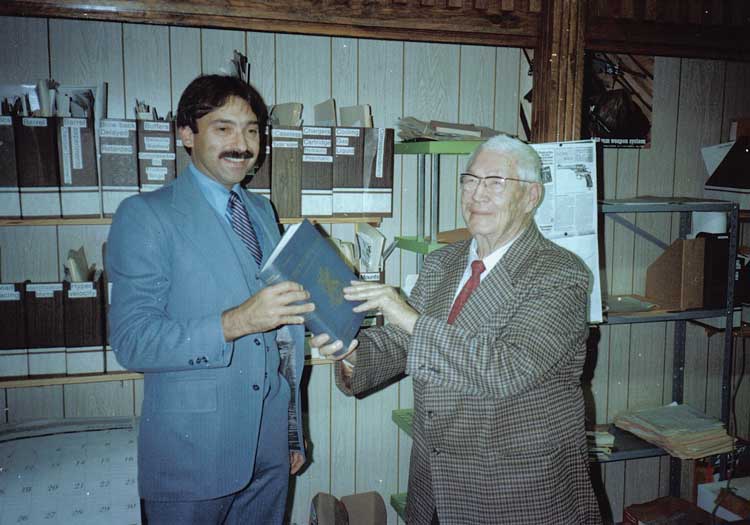
George: Let’s talk about The Machine Gun book series for a moment. I’ve always wondered how Chinn was able to get so much design information on all of those weapons – especially the foreign ones. It was before the information age and there was no internet to help him.
Buddy: Chinn made extensive use of the U.S. Patent Office. Patents on various guns, components, and feed mechanisms gave him a wealth of information about the theory and the design approach because that’s what patents do. It turns out that foreign patents were filed in the U.S. Patent Office as well so the foreigners could protect their concepts in the U.S. Chinn had a whole team under his direction researching patents. During their research they ran into some patents they believed could affect national security and should have been assigned a security classification, like Top Secret, or at least Secret. Chinn, a Major at the time, reported their findings and was told by his commanding officer: “If what you are saying turns out to not be true, it will be your last day in the Marine Corps.” This had Chinn worried for a while, but he trusted his own judgment and that of his team. Sure enough they were correct and the security leak was plugged.
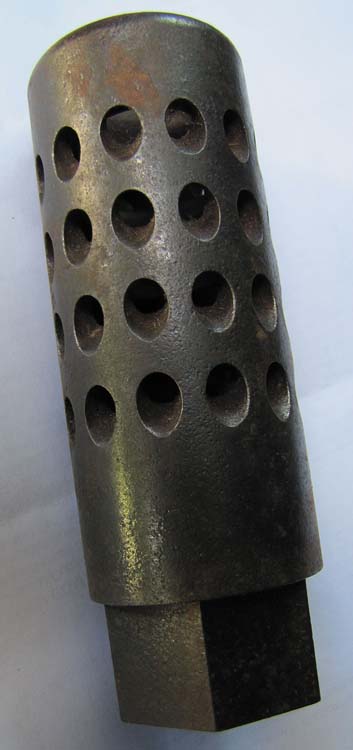
George: After he left the USMC what did he do?
Buddy: He was called back into the Marine Corps and went to work at the Naval Ordnance Station in Louisville. Bill Schnatter, Walt Cashen and George made up the design team that was awarded a patent on the Mk19 mechanism. He developed the 20mm/30mm Mk22 canon there too.
George: And after that?
Buddy: In later years, Chinn was like a guru for guns. People would come from all around to check out their designs with Chinn. Even the U.S. Government ran new designs by him to get his opinion on their viability.
George: Did Chinn ever get involved with hand-held small arms?
Buddy: Because of his vast experience, the U.S. Army JSSAP (Joint Service Small Arms Program) tried to get him to work on a new military rifle. Chinn wasn’t real excited about the idea but the JSSAP people kept after him, even sending down representatives from the Navy at Crane and their top gun guy in Washington DC. I guess they figured if the Navy asked, Chinn might work on it. All of his life Chinn had worked on bigger guns and there is a difference between guns fired from hard mounts and guns fired from the shoulder. He finally conceded, going along for a little while to see where it would lead. In considering the new rifle, George decided to use recoil operating cycle rather than a gas drive. George knew that recoil operated weapons didn’t have the guns gas residue and erosion problem and plus you could fool with the operating cycle and maybe even reduce the recoil. For his prototype he started with an old Remington Model 8 recoil operated rifle originally chambered for .35 Remington. First we converted it to fire 7.62mm and made some other modifications. When we had the design completed, we went over to Ft. Knox to demonstrate it. Due to time constraints and our limited manufacturing resources, we decided against converting our sample to fire full auto. Instead, we bought one of those inexpensive BMF activators – you know, one of those hand crank devices that attaches to the trigger guard and pulls the trigger multiple times for every rotation of the crank. We went out to the range and unexpectedly found our friend Bill Schnatter. He was there demonstrating the Mk19 and we were requested to share the range to demonstrate our rifle. We shot it semi-auto for a while and the gun worked perfectly. Then we decided to show the “full auto” capability, even though the rifle only had a five-round magazine. We spun up that BMF and cranked off a 5 round burst. Bill Schnatter looked up from his test site and yelled out: “Looks like the Colonel has done it again.”
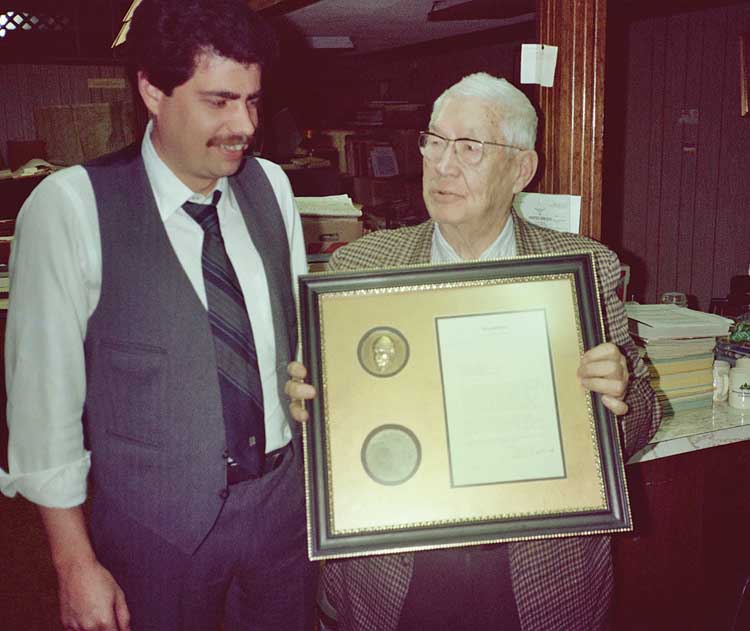
George: Buddy, as you think back on your grandfather’s long association with machine guns, who did he admire most?
Buddy: Without a doubt, he most admired John M. Browning. He had met members of the Browning family and was presented with a medallion from Val Browning, John’s son. This plaque was one of his most cherished possessions. Chinn was more than dismayed by the lack of progress made in gun design since Browning and was often heard to say: “We ought to dig up John M. Browning and see if he might have left us another gun design in his vest pocket.”
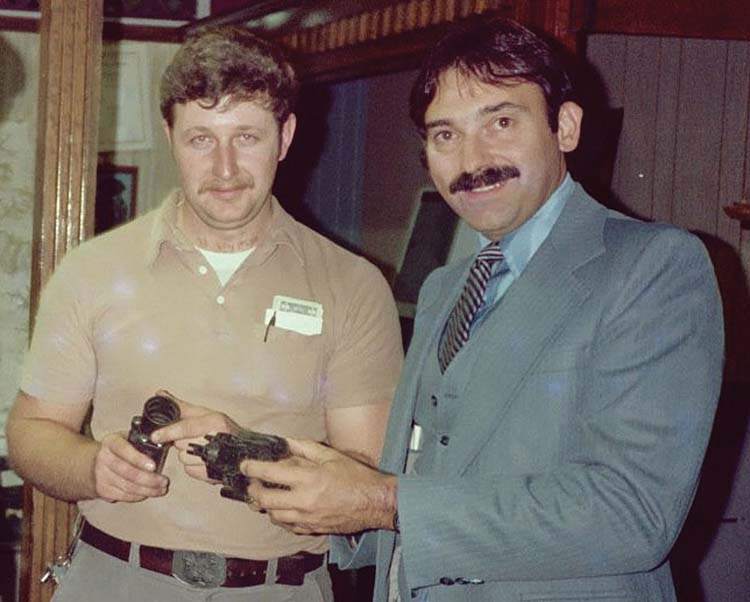
George: I seem to recall a similar comment he made about German machine guns.
Buddy: Yes, it’s in one of the books in The Machine Gun series where he compared our development programs to the German’s. He said: “True to the German military tradition, they sought to build tomorrow’s weapons today. In contrast, it has always been our custom to build yesterday’s weapons soon.”
George: George M. Chinn is remembered for his wisdom and sage remarks. Can you recall some examples so we can get a better insight into the man?
Buddy: That’s a tall order, but I’ll try. Even though George Chinn was not above calling in a political favor from time to time, he actually had no use for politics. He was incensed when politics affected the gun business and he’d say that it had no business there. Chinn’s success was characterized by a man who had a keen insight into knowing when to quit. Whether it was a business venture, horse racing, drinking whiskey, or pursuing a design approach, knowing when to pull up stakes and move on was a human character trait that served him well through the years – like his decision to give up drinking whiskey. Chinn believed that the proof of any good design was to put it into practice. He was known to remark: “I’ve never had a malfunction on paper.” That being said, he and his co-workers would make every effort to make their designs fool proof, but were always confounded by users who would still find a way to cause a failure or a malfunction. This led to one of his favorite expressions, though not original: “You can make something foolproof, but not damn fool proof.” George Chinn had a lot going for him but he never let it go to his head. He would jokingly say, “I am thought of highly in low places.” Of course, this was much earlier than the country tune with the same theme.
On our way to lunch, Buddy took me past some other buildings with Chinn connections. The old family house is possibly one of the oldest in Harrodsburg and was built from two log cabins that were merged into a single house where parents live. Buddy and his father have been working together restoring the house, room by room, starting with the living room where Chinn and his wife Cotton were married. Around town, construction sites mark the landscape of this historic city. A historic marker, near the war memorial, memorializes George M. Chinn for his contributions to the field of small arms.
Late in the afternoon, Buddy and I drive a winding road that leads to the Brooklyn Bridge and the Cave House. As we near the river, the road hugs a sheer cliff on the left that faces a lush riverbank on the right. A chain link fence marks off the grounds and prevents intruders from entering the remains of the cave house. It is evident that the roots from a number of large trees have lost their grip on the thin soil in the cliff above and have come crashing down into the Cave House compound. Buddy and his son have been clearing them out. Even in its present condition the Cave House is impressive. Buddy: (Buddy points to a large storage box at the Cave House entrance.) When Chinn was working on the Mk19 he leased the Cave House to the Navy for a dollar a year. They did their testing inside and stored their ammo in that box at night. George: (Fast moving vehicles slow to rubberneck when they see the two of us – and me with a camera – examining the Cave House.) Do you suppose they’re looking for a sandwich or a little slot action? Buddy: No, I’ll be answering a lot of questions from the locals. Around here, there is a certain mystique about George Chinn and amazing rumors have developed surrounding the Cave House and Chinn’s home. There are people who believe George had machine guns mounted on his roof and other outrageous things.
As the sun sets over the Cave House, I feel a bit guilty of taking up so much of Buddy’s day. I thank him for sharing his insight into the life of a man we have long admired.
| This article first appeared in Small Arms Review V14N2 (November 2010) |










